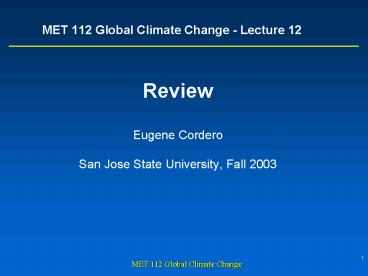MET 112 Global Climate Change Lecture 12 - PowerPoint PPT Presentation
1 / 39
Title:
MET 112 Global Climate Change Lecture 12
Description:
As you know, water vapor is a greenhouse gas. ... in the annual data (thin black whisker bars represent the 95% confidence range) ... – PowerPoint PPT presentation
Number of Views:31
Avg rating:3.0/5.0
Title: MET 112 Global Climate Change Lecture 12
1
MET 112 Global Climate Change - Lecture 12
- Review
- Eugene Cordero
- San Jose State University, Fall 2003
2
- Lecture 2-3
3
(No Transcript)
4
Solar vs. Terrestrial Radiation
- The sun is much hotter than planets therefore,
sunlight consists of shorter wavelengths than
planetary radiation - Thus
5
(No Transcript)
6
- As you know, water vapor is a greenhouse gas.
Explain, using the previous diagram, why water
vapor is a greenhouse gas.
7
(No Transcript)
8
- Explain what would happen to these energy
estimates if the Earths albedo was to increase.
9
Some atmospheric radiation escapes to space
Some surface radiation escapes to space
Greenhouse gases emit longwave upward and downward
Most outgoing longwave is absorbed in atmosphere
(by greenhouse gases)
Some atmospheric radiation is absorbed at the
surface
Longwave radiation is emitted from surface.
10
Comparison of Earth and Venus
Earth
Venus
Venus is completely covered by highly reflective
clouds Earth is partially covered by clouds.
Which planet has a higher albedo?
_______________
Venus
11
- Lecture 4
12
Why do we have seasons?
13
- Explain the following diagram.
14
(No Transcript)
15
(No Transcript)
16
- Lecture 5
17
Water freely evaporating and condensing
18
(No Transcript)
19
- Lecture 6
20
The Earths history can be characterized by
different geologic events or eras.
21
Evolution of atmospheric oxygen
0xygen in atmosphere
0
10
20
22
Temperature Graph
Source http//www.ruf.rice.edu/leeman/aNR.html
23
- Lecture 7
24
(No Transcript)
25
(b) Additionally, the year by year (blue curve)
and 50 year average (black curve) variations of
the average surface temperature of the Northern
Hemisphere for the past 1000 years have been
reconstructed from proxy data calibrated
against thermometer data (see list of the main
proxy data in the diagram). The 95 confidence
range in the annual data is represented by the
grey region. These uncertainties increase in more
distant times and are always much larger than in
the instrumental record due to the use of
relatively sparse proxy data. Nevertheless the
rate and duration of warming of the 20th century
has been much greater than in any of the previous
nine centuries. Similarly, it is likely7 that the
1990s have been the warmest decade and 1998 the
warmest year of the millennium.
26
Figure 1 Variations of the Earths surface
temperature over the last 140 years and the last
millennium.(a) The Earths surface temperature
is shown year by year (red bars) and
approximately decade by decade (black line, a
filtered annual curve suppressing fluctuations
below near decadal time-scales). There are
uncertainties in the annual data (thin black
whisker bars represent the 95 confidence range)
due to data gaps, random instrumental errors and
uncertainties, uncertainties in bias corrections
in the ocean surface temperature data and also in
adjustments for urbanisation over the land. Over
both the last 140 years and 100 years, the best
estimate is that the global average surface
temperature has increased by 0.6 0.2C.
27
- Lecture 8
28
The Faint-Sun Paradox (Cont.)
- What would happen if the suns energy output
dropped by 30? - With todays albedo and greenhouse gas
concentrations, here is what would happen to the
surface temperature as the sun got weaker and
weaker
29
- Lecture 9-10
30
(No Transcript)
31
The Earths history can be characterized by
different geologic events or eras.
32
Silicate-to-Carbonate Conversion
Rain
1. CO2 Dissolves in Rainwater
2. Acid Dissolves Silicates (carbonic acid)
3. Dissolved Material Transported to Oceans
4. CaCO3 Forms in Ocean and Settles to the Bottom
Land
Calcium carbonate
33
Time Scale of Long-Term Carbon Cycle
- Suppose that a 1 imbalance developed
- How long would it take to double the amount of
carbon in the atmosphere-ocean-biosphere?
Carbon Content 40, 000 Gt.
0.0297 Gt./yr
0.0003 Gt./yr
0.0300 Gt./yr
Net Carbon Flux
Carbon Content 40, 000, 000 Gt.
Answer 40, 000/.0003 years 133 million years
34
Organic Carbon Burial Process
O2
CO2 Removed by Photo-Synthesis
CO2 Put Into Atmosphere by Decay
C
C
Some Carbon escapes oxidation
C
35
Oxidation of Buried Organic Carbon
Atmosphere
CO2
O2
C
Buried Carbon
36
The (Almost) Complete Long-Term Carbon Cycle
(Diagram)
Atmosphere (CO2) Ocean (Dissolved CO2) Biosphere
(Organic Carbon)
Subduction/Volcanism
Oxidation of Buried Organic Carbon
Silicate-to-Carbonate Conversion
Organic Carbon Burial
Carbonates
Buried Organic Carbon
37
- How would a global increase in volcanism change
the long term carbon cycle?
38
- As objects get warmer, they emit (more/less/same)
amount of radiation. - Clouds ________ infrared radiation and _________
visible radiation (absorb/reflect). - Which latitude has the most hours of daylight on
Dec 22nd? - 60S, 30S, 0, 30N, 60N
- Explain how an increase in surface ice may affect
climate?
39
- Question from assigned articles reading































